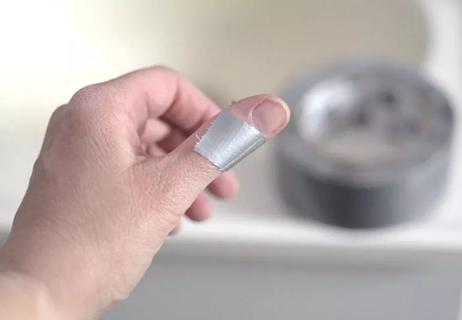It’s an effective treatment, but only on certain kinds of warts

Every once in a while, you hear about a home health remedy that’s so wacky, it has to be real. Why? Well, because nobody would believe it otherwise.
Advertisement
Cleveland Clinic is a non-profit academic medical center. Advertising on our site helps support our mission. We do not endorse non-Cleveland Clinic products or services. Policy
This is one of those times.
If you or your child has a wart, you should really consider putting duct tape on it. Seriously. Not only is it an effective home remedy, but it’s also affordable.
Don’t believe us? Honestly, we can’t blame you. It’s a bit out there. That’s why we asked dermatologist Melissa Piliang, MD, to explain why duct tape works, what kind of warts you can use it on and when you need to put down the tape and head to the doctor instead.
The duct-tape occlusion method is very simple:
Advertisement
You can also use duct tape in concert with over-the-counter treatments like a 20%–40% salicylic acid gel, says Dr. Piliang. By themselves, these treatments may take weeks or months to work. Together, things could move faster.
Have you ever noticed that your skin looks a bit odd when it’s been covered with a bandage for a while? Duct tape has a similar effect, says Dr. Piliang.
“Covering warts with duct tape makes the skin wet, pale and wrinkly, which isn’t an ideal environment for a wart,” she explains. She also notes that duct tape is such a strong adhesive that — when you pull it off — you’re likely to remove a layer of the wart along with it.
Some experts think that the chemicals in duct tape’s adhesive could be triggering an immune response, speeding up the healing process. Others note that warts usually resolve by themselves eventually. And maybe keeping it covered isn’t doing anything to treat the wart, but it is preventing the virus from spreading to other parts of your skin.
Duct tape occlusion is only an effective treatment for certain kinds of warts on certain parts of your body. Don’t use duct tape if:
You know the scene in movies where the hero rips the duct tape off the mouth of the dude that’s been kidnapped? You know how said dude never looks super thrilled about it? Now imagine doing it to yourself by choice.
While it’s likely going to be less painful than freezing a wart, for example, that doesn’t mean ripping duct tape off yourself is going to be fun. If you have sensitive skin — or a condition like eczema or psoriasis — it could be downright damaging. And, of course, if you’re allergic to the materials in duct tape, you could end up with a nasty case of contact dermatitis.
It’s perhaps unsurprising, then, that the most common side effects of duct tape occlusion all have to do with skin irritation: bleeding, rash and redness.
Just because treating warts with duct tape is easy doesn’t mean it’s fast. In fact, you can expect the duct tape occlusion method to take weeks. It may even take months.
“If the wart is still there after two months, it’s probably time to speak to your doctor about other options, like freezing or laser treatment,” Dr. Piliang advises.
The goal of duct tape occlusion is to avoid a trip to the doctor, but that isn’t always possible. Give a call to the doctor’s office if:
Advertisement
Advertisement
Learn more about our editorial process.
Advertisement

Some warts will clear up on their own, but others may need home remedies or medical care

You’ll be surprised which weird remedies actually make a difference

It’s best to avoid picking at zits, which can damage your skin (though there are ways to minimize the risk)

Both inflammatory conditions have varying triggers and symptoms

Strengthening your skin barrier, simple routines and minimizing products are ongoing, popular trends

Early attention to skin wounds can help minimize their appearance later

Several conditions, like vitiligo and fungal infection, can cause a loss of pigmentation, leading to white spots or patches on your skin

Moisturizing, running a humidifier and adjusting your showers may help keep itchiness and irritation at bay

Start having sex about 72 hours before ovulation, then at least every other day during your fertile window

Attachment theory suggests that your earliest relationships shape connections throughout your life

It isn’t a recognized mental health disorder, but research shows that problematic social media use can negatively affect your mental health, self-esteem and sleep